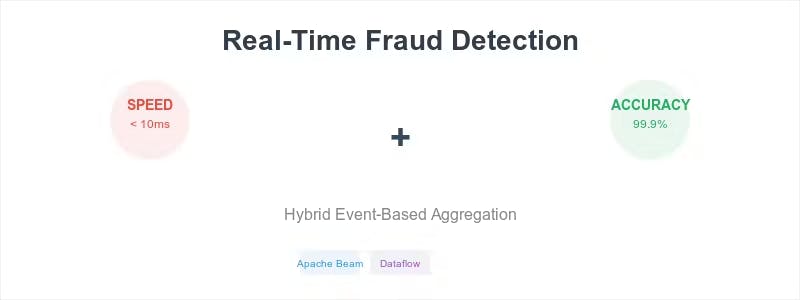In modern fraud detection systems, a critical challenge emerges: how do you achieve both lightning-fast response times and unwavering reliability? Most architectures force you to choose between speed and consistency, but there’s a sophisticated solution that delivers both.
Traditional event-driven systems excel at immediate processing but struggle with sparse activity patterns and external query requirements. When events don’t arrive, these systems can leave aggregations incomplete and state stale – a significant liability in financial services where every millisecond and every calculation matters.
This post explores hybrid event-based aggregation – an architectural pattern that combines the immediate responsiveness of event-driven systems with the reliability of timer-based completion. We’ll examine real-world implementation challenges and proven solutions that have processed billions of financial events in production.
The Core Challenge: When Event-Driven Systems Fall Short
Event-driven architectures have transformed real-time processing, but they reveal critical limitations in fraud detection scenarios. Understanding these constraints is essential for building robust financial systems.
Problem 1: The Inactivity Gap
Consider a fraud detection system that processes user behavior patterns. When legitimate users have sparse transaction activity, purely event-driven systems encounter a fundamental issue.
Figure 1: Pure event-driven systems struggle with sparse user activity, leading to incomplete aggregations
Without subsequent events to trigger completion, aggregation state persists indefinitely, creating several critical issues:
- Stale State Accumulation: Outdated calculations consume memory and processing resources
- Logical Incorrectness: Temporary spikes trigger persistent alerts that never reset automatically
- Resource Leaks: Unclosed aggregation windows create gradual system degradation
Problem 2: The External Query Challenge
Real-world fraud systems must respond to external queries regardless of recent event activity. This requirement exposes another fundamental limitation of pure event-driven architectures.
Figure 2: External systems requesting current state may receive stale data when no recent events have occurred
When external systems query for current risk scores, they may receive stale data from hours-old events. In fraud detection, where threat landscapes evolve rapidly, this staleness represents a significant security vulnerability and operational risk.
The Hybrid Solution: Dual-Trigger Architecture
The solution lies in combining event-driven responsiveness with timer-based reliability through a dual-trigger approach. This architecture ensures both immediate processing and guaranteed completion.
Core Design Principles
The hybrid approach operates on four fundamental principles:
- Event-Triggered Processing: Immediate reaction to incoming data streams
- Timer-Triggered Completion: Guaranteed finalization of aggregations after inactivity periods
- State Lifecycle Management: Automatic cleanup and resource reclamation
- Query-Time Consistency: Fresh state available for external system requests
Production Architecture: Building the Hybrid System
Let’s examine the technical implementation of a production-ready hybrid aggregation system. Each component plays a crucial role in achieving both speed and reliability.
Event Ingestion Layer
Figure 3: Event ingestion layer with multiple sources flowing through partitioned message queues to ensure ordered processing
Key Design Decisions:
- Partitioning Strategy: Events partitioned by User ID ensure ordered processing per user
- Event Time vs Processing Time: Use event timestamps for accurate temporal reasoning
- Watermark Handling: Manage late-arriving events gracefully
2. Stream Processing Engine (Apache Beam Implementation)
# Simplified Beam pipeline structure
def create_fraud_detection_pipeline():
return (
p
| 'Read Events' >> beam.io.ReadFromPubSub(subscription)
| 'Parse Events' >> beam.Map(parse_event)
| 'Key by User' >> beam.Map(lambda event: (event.user_id, event))
| 'Windowing' >> beam.WindowInto(
window.Sessions(gap_size=300), # 5-minute session windows
trigger=trigger.AfterWatermark(
early=trigger.AfterProcessingTime(60), # Early firing every minute
late=trigger.AfterCount(1) # Late data triggers
),
accumulation_mode=trigger.AccumulationMode.ACCUMULATING
)
| 'Aggregate Features' >> beam.ParDo(HybridAggregationDoFn())
| 'Write Results' >> beam.io.WriteToBigQuery(table_spec)
)
3. Hybrid Aggregation Logic
The core of our system lies in the HybridAggregationDoFn that handles both event and timer triggers:
Figure 4: State machine showing the dual-trigger approach – events trigger immediate processing while timers ensure guaranteed completion
Implementation Pattern:
class HybridAggregationDoFn(beam.DoFn):
USER_STATE_SPEC = beam.transforms.userstate.BagStateSpec('user_events', beam.coders.JsonCoder())
TIMER_SPEC = beam.transforms.userstate.TimerSpec('cleanup_timer', beam.transforms.userstate.TimeDomain.PROCESSING_TIME)
def process(self, element, user_state=beam.DoFn.StateParam(USER_STATE_SPEC),
cleanup_timer=beam.DoFn.TimerParam(TIMER_SPEC)):
user_id, event = element
# Cancel any existing timer
cleanup_timer.clear()
# Process the event and update aggregation
current_events = list(user_state.read())
current_events.append(event)
user_state.clear()
user_state.add(current_events)
# Calculate aggregated features
aggregation = self.calculate_features(current_events)
# Set new timer for cleanup (e.g., 5 minutes of inactivity)
cleanup_timer.set(timestamp.now() + duration.Duration(seconds=300))
yield (user_id, aggregation)
@beam.transforms.userstate.on_timer(TIMER_SPEC)
def cleanup_expired_state(self, user_state=beam.DoFn.StateParam(USER_STATE_SPEC)):
# Finalize any pending aggregations
current_events = list(user_state.read())
if current_events:
final_aggregation = self.finalize_features(current_events)
user_state.clear()
yield final_aggregation
4. State Management and Query Interface
Figure 5: Multi-tier state management with consistent query interface for external systems
State Consistency Guarantees:
- Read-Your-Writes: Queries immediately see the effects of recent events
- Monotonic Reads: Subsequent queries never return older state
- Timer-Driven Freshness: Timers ensure state is never more than X minutes stale
5. Complete System Flow
Figure 6: End-to-end system architecture showing data flow from event sources through hybrid aggregation to fraud detection and external systems
Advanced Implementation Considerations
Watermark Management for Late Events
Figure 7: Timeline showing event time vs processing time with watermark advancement for handling late-arriving events
Late Event Handling Strategy:
- Grace Period: Accept events up to 5 minutes late
- Trigger Configuration: Process immediately but allow late updates
- State Versioning: Maintain multiple versions for consistency
Conclusion
Hybrid event-based aggregation represents a significant advancement in building production-grade fraud detection systems. By combining the immediate responsiveness of event-driven processing with the reliability of timer-based completion, organizations can build systems that are both fast and reliable.
The architecture pattern described here addresses the core limitations of pure event-driven systems while maintaining their performance benefits. This approach has been proven in high-scale financial environments, providing a robust foundation for modern real-time fraud prevention systems.
Key benefits include:
- Sub-10ms response times for critical fraud decisions
- Guaranteed state consistency and completion
- Scalable processing of millions of events daily
- Automated resource management and cleanup
As fraud techniques become more sophisticated, detection systems must evolve to match both their speed and complexity. Hybrid event-based aggregation provides exactly this capability.
This architecture has been successfully deployed in production environments processing billions of financial events annually. The techniques described here are based on real-world implementations using Apache Beam, Google Cloud Dataflow, and modern stream processing best practices.


















